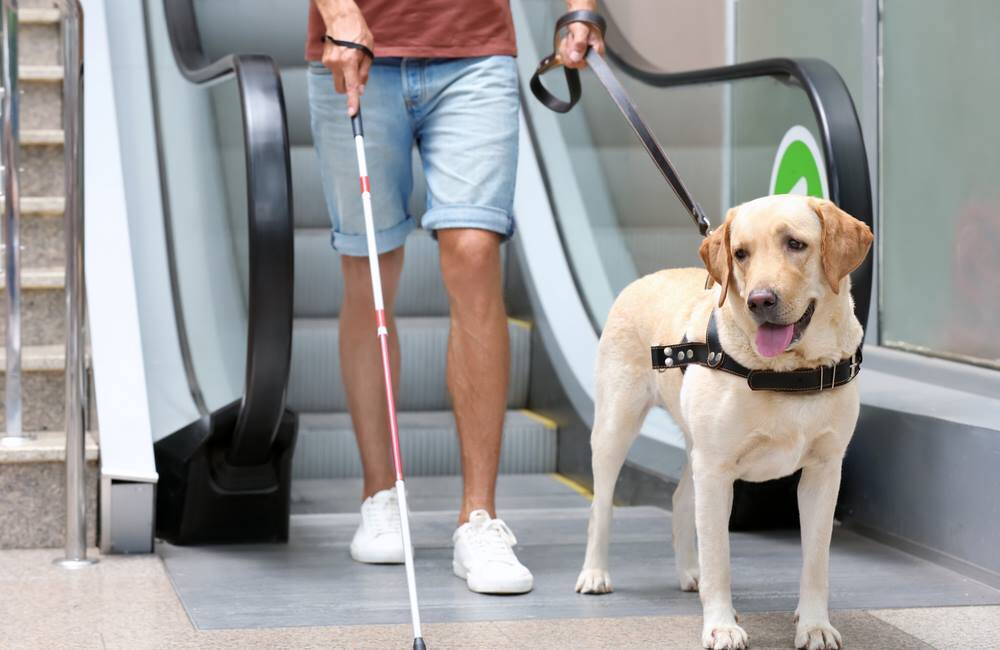For those who need to travel with a guide dog, getting through the airport and boarding a plane can seem a daunting task. However, there are animal airport disability assistance services available that can help you through the experience, as well as personnel at the airport who are trained to support those with a guide dog.
In the modern world, the need to travel with a guide dog should not keep people from taking a trip they need or want to take. Keep the following steps in mind to ensure that your trip goes well.
Plan Ahead
Organizations such as the Guide Dog Foundation, Inc. will provide demonstrations and practices of what to expect at airport security, so you and your guide dog are fully prepared and confident during the real thing. If you contact TSA Cares 72 hours before a flight, they will also provide you with information on what to expect. TSA Cares can also coordinate a passenger support specialist to help you through the airport.
Picking a Good Day
Early morning flights are often best because they experience the fewest delays. Traveling on Friday can present more challenges as that is most often the busiest day at an airport. Saturdays are usually the lightest day for travel.
Packing for Your Trip
Remember to put your travel-sized liquids in a quart-sized bag, and make sure any electronics larger than a cell phone are easily accessible so you can remove them during screening. Liquids over 3.4 ounces are not allowed through airport security, unless said liquid is medically necessary, though you will have to declare this to the TSA agents at the screening for inspection.
Pack For Your Guide Dog
Make sure to pack a small emergency-size kit for your guide dog. This should include items such as medicine for an upset stomach, hand wipes and paper towels.
Mapping Out the Airports
When you travel with a guide dog, look up the airports you are going to be in to find the pet-friendly, animal airport areas where you can sit and wait in case there is a flight delay. The website Pet-Friendly Travels provides such a list. Also look for the location of bathrooms, places where you can water or other items, etc.
Packing Dog Meals
Make sure to pack pre-measured meals for your guide dog. They are not prohibited and can be put into resealable plastic bags in your luggage. Make sure to bring a small amount of food and whatever treats are appropriate for your dog in the case of lengthy delays at the airport or on the plane.
Reserve a Seat
Contact the airline at least one day before departure – the earlier, the better – to secure the seat you need for you and your guide dog. Some prefer to sit against the bulkhead. Airlines that do not allow you to purchase a seat location in advance will allow you to pre-board before the other passengers. Dogs can sit anywhere, as long as no part of their body is in the aisle. In some cases, you may have to ask a fellow traveler to share some of their foot space with your dog – an airline representative can help you in this situation.
Going Through Screening
There is no point during screening at which you will be separated from your guide dog or required to remove your dog’s harness and leash, though your dog may have to go through additional screening if you leave these items on. You will have to remove your jacket, belt, and shoes (unless you have TSA Pre-Check). If you are unable to do so, you will go through additional screening. You may also have to walk through a metal detector or receive a pat-down.
Pat-Down Checks
The pat-down will always be conducted by an officer of the same gender as your present, and they will walk you through the process beforehand. They will ask for permission before touching your guide dog, and you can always request a private screening with a companion of your choice or ask that the officer use a new pair of gloves.
Advocate and Ask for Help
Do not hesitate to ask airport workers, airplane personnel and even fellow passengers for assistance, if needed. Under federal law, airports and airlines must provide accommodations for those with disabilities. And fellow passengers are often far more helpful than you might expect! Also, ask to speak with an airline representative who is designated to work with those who have disabilities if you run into any difficulties anywhere along the process. These are some tips to review before you travel with a guide dog. With the help of those at the airport and your own preparation, it’s a process that can and should go smoothly as the world gets better at supporting those who are differently abled.
